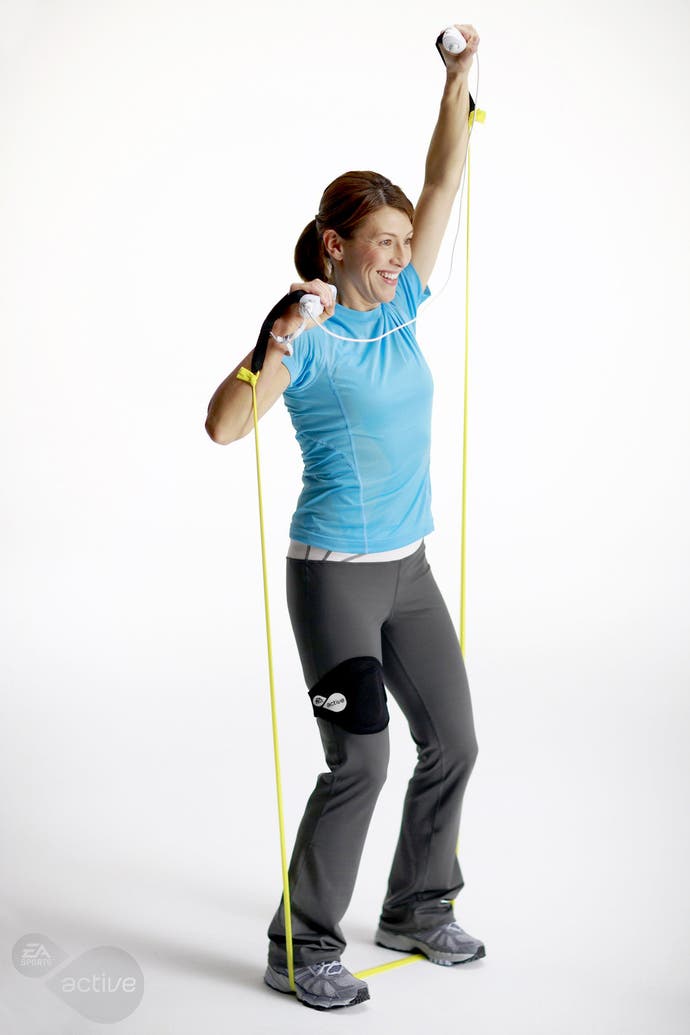EA Sports Active
Perfect fit?
Something strange happened last April. I started running. Outside. Three times a week. Regular as clockwork. The same month, Nintendo launched Wii Fit. No coincidence. I've barely touched Wii Fit in the last year, but I'm still running.
However thick the layer of dust now on the balance boards of early adopters, if the continued soaraway success of Wii Fit tells us anything, it's that there is at the very least an appetite amongst Wii owners to be healthier. Of course, for others there remains an appetite to binge on KFC until chicken fat dribbles from their squinting, bloodshot eyes, but such is the nature of gaming's ever-broadening audience.
The genius of Wii Fit is that it made exercise fun, just as Brain Training did it for maths. Aside from all the yoga flailing and straight-faced routines, it was packed with charming, foolish, unmistakably Nintendo mini-games that were a lark to play, especially with others, and effectively tricked you into physical exertion without you thinking about it.
EA Sports Active wouldn't exist without Nintendo's prior success here. Wii Fit proved not just that there's an audience for virtual fitness (let's bury that dreadful 'exergaming' tag for good, please), but that it can also sell squillions. (Wii Fit is currently number 4 in the UK charts, over a year after release; two spots, incidentally, above EA Sports Active).
A PE teacher in a former life, this was an opportunity too good to miss for the newly installed overlord of EA Sports, Peter Moore. But the two products are vastly different. And before I get into a more detailed analysis, let me be clear: EA Sports Active won't have you grinning like an idiot (more likely crying); it won't be whipped out at parties for a laugh; and I certainly wouldn't play it with my mum; but, if your goal is fitness rather than pure fun, it's currently the best you can buy.

EA's been keen to draw the distinction between Wii Fit's "eastern" approach to fitness, all holistic and yoga-fuelled, offering up an abstract "Fitness Age" to chart your progress. Active is much more targeted and goal-oriented. It's an interactive trainer that barks encouragement and advice at you through a routine, just as one would in a real gym. There are no hula hooping Miis; there's no penguin slide; there's no yoga. It is, as it says on the box, a "personal trainer".
Active doesn't have anything as fancy as a balance board to come bundled with (although it supports it), but it is packaged with a leg strap and a resistance band. The former is secured around your thigh and features a little pocket for the nunchuk, which measures leg movements during certain exercises. The latter is used for upper body training, the band placed under both feet, its ends gripped in either hand along with the nunchuk and Wiimote.
In general the exercises in Active are focused on increasing strength and stamina and promoting weight loss (performance is measured in calories burned rather than by an "age" marker). The best place to start, and a brilliant feature, is the 30-Day Challenge: a month-long workout programme designed to deliver real improvements while systematically introducing you to the various types of exercises on offer.
Already, I've stuck with this far longer than I remained regularly committed to Wii Fit, whose novelty wore off dramatically after the initial buzz. Each day you have the option to choose between a low, medium or high intensity workout and whether you want to use a balance board in certain exercises. Then your trainer (you can choose a bloke or a bird, real people, with wholesome, pearly white American grins) offers up info on today's list of exercises, how long the workout will take, and a projected calorie burn target (which seems set deliberately low to give you an extra smug bonus when you exceed it every time).

You can easily remove any exercise you don't fancy. Since getting into the groove with it, I've taken to ditching the running-on-the-spot cardio in favour of going for an actual run around my local park first, then getting stuck into my Active session.
And your trainer is a surprisingly effective motivator. While I love scampering around the streets of W9, I wouldn't be caught dead doing lunges, squats and the like of my own accord. I simply lack the motivation. But when my TV is barking at me to push it harder, showering me with pre-recorded praise, it genuinely works. And that's exactly what people pay personal trainers to do.
Out of the box, Active's much better at lower-body workouts. Anyone unfortunate enough to follow me on Twitter [I'm not putting in a link - Ed] will have read frequent post-session updates on the burning pain searing through my thighs after another series of brutal leg drills. Inline Skating is a particular evil: starting from a squat position, the lower you are the faster you skate, and once you reach a ramp you have to jump in the air and immediately land back in the squat position. After my first 'high intensity' session, my legs were in agony for two days. There's just no way I'd push myself to complete 24 'stunt jumps' without either this game, a real trainer, or 10 pints of lager as a completion bonus.
By placing the nunchuk in the leg strap, Active is able to determine how low you are crouching, which is essential for squat- and lunge-based exercises, as it is for cardio-based routines like high knees.


